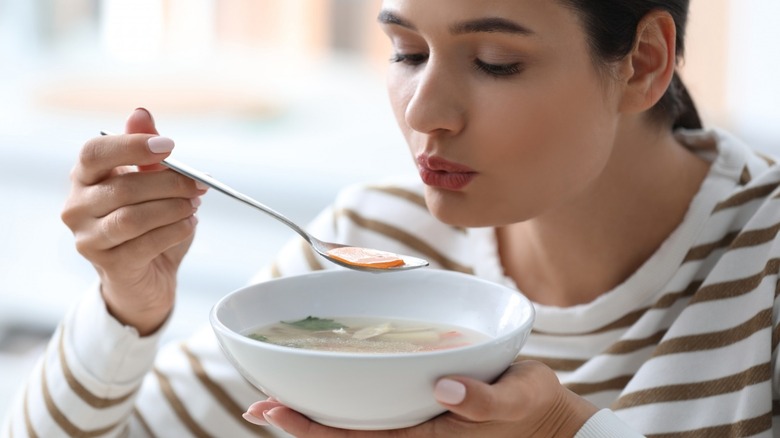Does Blowing On Hot Food Actually Make A Difference?
Coffee and fries are arguably two of the worst offenders when it comes to food using the power and hurt of heat as a vicious, calculating, and unexpected weapon. No matter how many hundreds or thousands of times we've been suddenly scalded by hot food or a burning drink, at some point, we are inevitably going to be caught again.
As well as causing you to curse like a sailor, the result of consuming overly hot food or drink is, unsurprisingly, pain. Cleveland Clinic explains that the main problem is that extreme heat irritates the lining of the throat, which, with persistent consumption of burning items, could cause inflammation.
So, how do you stop food or drink from causing you discomfort? The obvious answer is to wait for it to cool down, but, let's be honest, nobody has time for patience anymore. The go-to tactic seemingly inherited at birth is to repeatedly blow on hot items until they drop to an acceptable temperature. However, does this actually work, or is it simply a waste of time?
Blowing on hot food helps to cool it down
Blowing on hot food can be a little embarrassing at times, especially when you're in a posh restaurant and the whole room is watching you force flecks of food to fly through the air. Fortunately, those efforts are not a waste of time — blowing on food and drink does help to cool them down.
When you blow on hot food, your cooler breath replaces the hot air released from the food through a process called convection, consequently cooling down the food. The process continually repeats itself with hot air from the food being replaced by cool air from your breath, explains ThoughtCo. BBC Science Focus adds that for hot drinks the rate of convection can be increased by stirring the drink, which brings hotter liquid to the surface quicker for it to be cooled.
Blowing on hot items also pushes away vapor clouds that form over hot drinks and moist food, replacing warm, damp air with dry, cool air, explains BBC Science Focus. This speeds up evaporation, notes ThoughtCo, allowing more water particles in drinks or on moist food to transform into gas, speeding up cooling as heat energy transfers from the item to the air.

